four wheel drive CHEVROLET KODIAK 2007 Owners Manual
[x] Cancel search | Manufacturer: CHEVROLET, Model Year: 2007, Model line: KODIAK, Model: CHEVROLET KODIAK 2007Pages: 430, PDF Size: 6.06 MB
Page 2 of 430
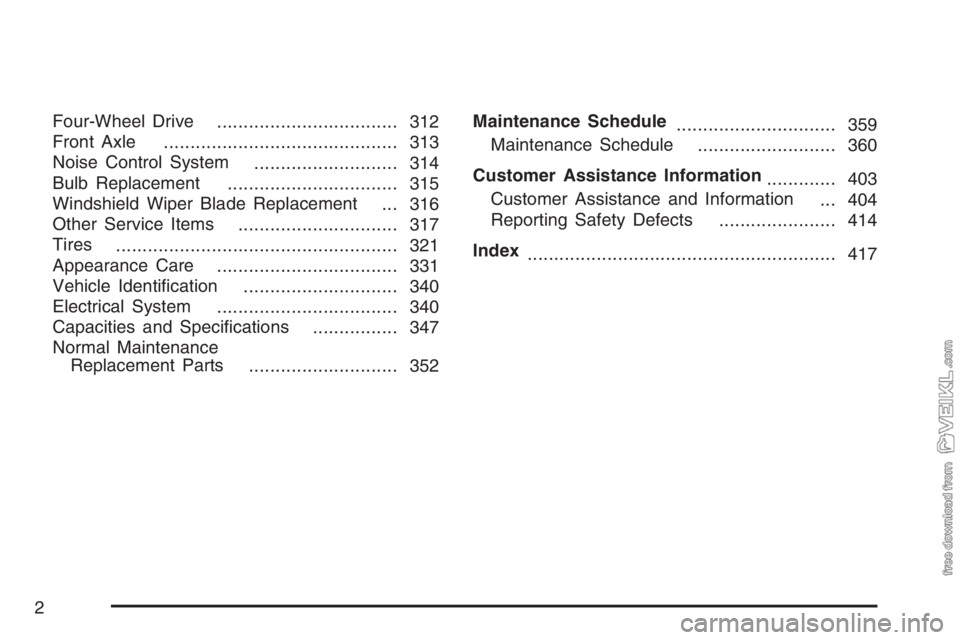
Four-Wheel Drive
.................................. 312
Front Axle
............................................ 313
Noise Control System
........................... 314
Bulb Replacement
................................ 315
Windshield Wiper Blade Replacement
... 316
Other Service Items
.............................. 317
Tires
..................................................... 321
Appearance Care
.................................. 331
Vehicle Identification
............................. 340
Electrical System
.................................. 340
Capacities and Specifications
................ 347
Normal Maintenance
Replacement Parts
............................ 352Maintenance Schedule
.............................. 359
Maintenance Schedule
.......................... 360
Customer Assistance Information
............. 403
Customer Assistance and Information
... 404
Reporting Safety Defects
...................... 414
Index
.......................................................... 417
2
Page 85 of 430
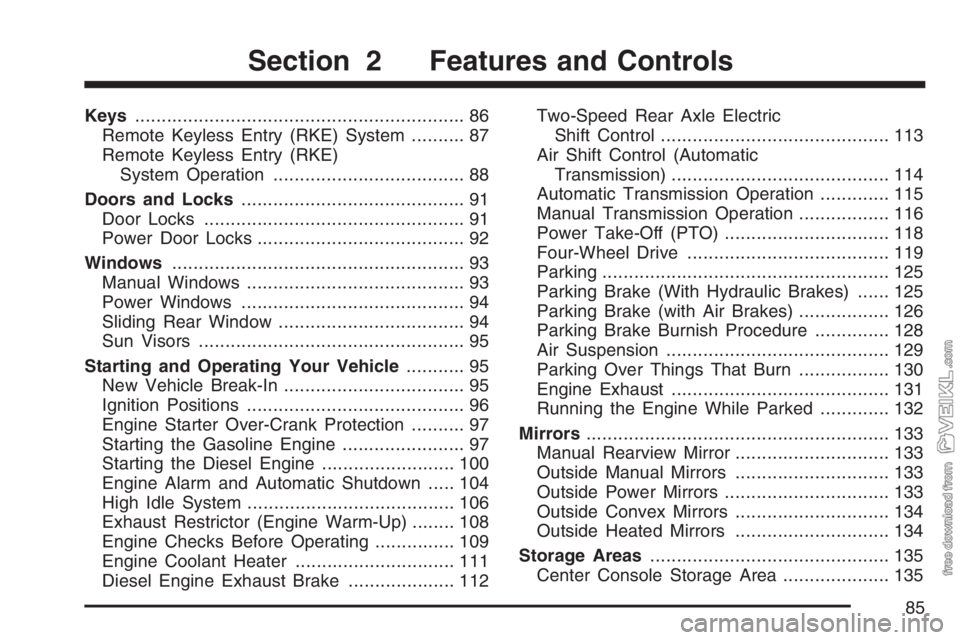
Keys.............................................................. 86
Remote Keyless Entry (RKE) System.......... 87
Remote Keyless Entry (RKE)
System Operation.................................... 88
Doors and Locks.......................................... 91
Door Locks................................................. 91
Power Door Locks....................................... 92
Windows....................................................... 93
Manual Windows......................................... 93
Power Windows.......................................... 94
Sliding Rear Window................................... 94
Sun Visors.................................................. 95
Starting and Operating Your Vehicle........... 95
New Vehicle Break-In.................................. 95
Ignition Positions......................................... 96
Engine Starter Over-Crank Protection.......... 97
Starting the Gasoline Engine....................... 97
Starting the Diesel Engine......................... 100
Engine Alarm and Automatic Shutdown..... 104
High Idle System....................................... 106
Exhaust Restrictor (Engine Warm-Up)........ 108
Engine Checks Before Operating............... 109
Engine Coolant Heater.............................. 111
Diesel Engine Exhaust Brake.................... 112Two-Speed Rear Axle Electric
Shift Control........................................... 113
Air Shift Control (Automatic
Transmission)......................................... 114
Automatic Transmission Operation............. 115
Manual Transmission Operation................. 116
Power Take-Off (PTO)............................... 118
Four-Wheel Drive...................................... 119
Parking...................................................... 125
Parking Brake (With Hydraulic Brakes)...... 125
Parking Brake (with Air Brakes)................. 126
Parking Brake Burnish Procedure.............. 128
Air Suspension.......................................... 129
Parking Over Things That Burn................. 130
Engine Exhaust......................................... 131
Running the Engine While Parked............. 132
Mirrors......................................................... 133
Manual Rearview Mirror............................. 133
Outside Manual Mirrors............................. 133
Outside Power Mirrors............................... 133
Outside Convex Mirrors............................. 134
Outside Heated Mirrors............................. 134
Storage Areas............................................. 135
Center Console Storage Area.................... 135
Section 2 Features and Controls
85
Page 119 of 430
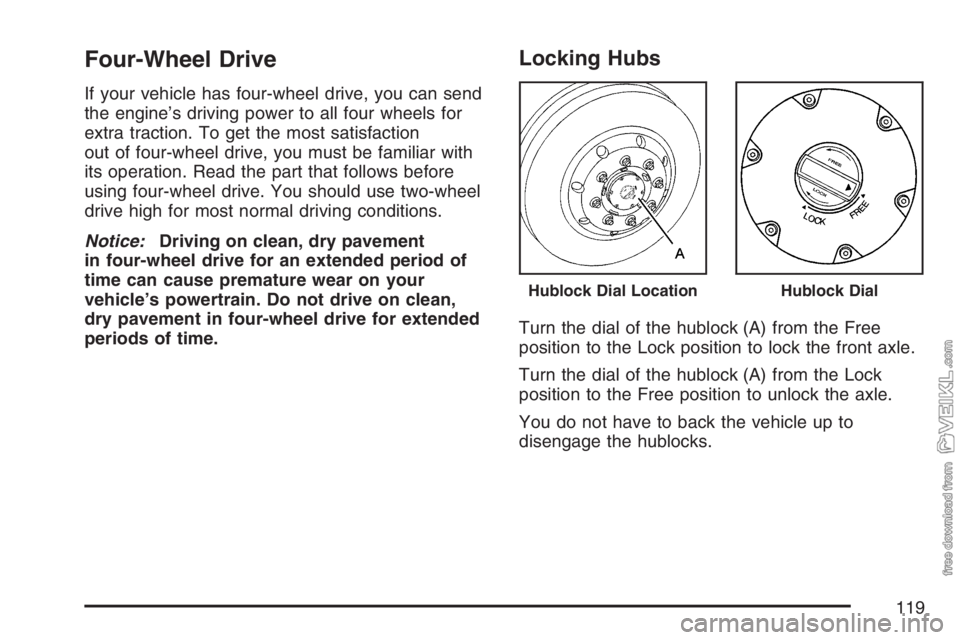
Four-Wheel Drive
If your vehicle has four-wheel drive, you can send
the engine’s driving power to all four wheels for
extra traction. To get the most satisfaction
out of four-wheel drive, you must be familiar with
its operation. Read the part that follows before
using four-wheel drive. You should use two-wheel
drive high for most normal driving conditions.
Notice:Driving on clean, dry pavement
in four-wheel drive for an extended period of
time can cause premature wear on your
vehicle’s powertrain. Do not drive on clean,
dry pavement in four-wheel drive for extended
periods of time.
Locking Hubs
Turn the dial of the hublock (A) from the Free
position to the Lock position to lock the front axle.
Turn the dial of the hublock (A) from the Lock
position to the Free position to unlock the axle.
You do not have to back the vehicle up to
disengage the hublocks.
Hublock Dial LocationHublock Dial
119
Page 120 of 430
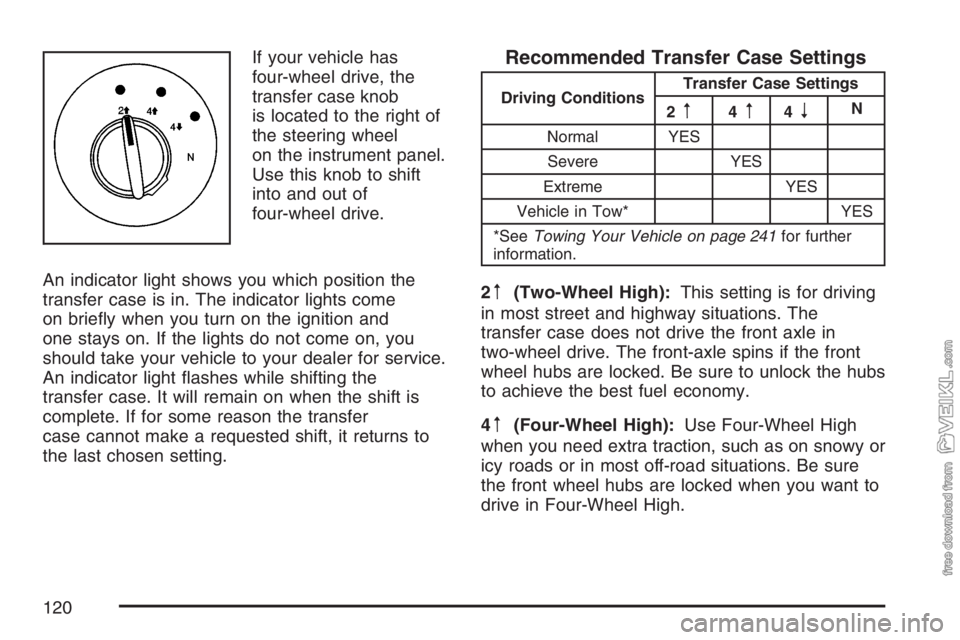
If your vehicle has
four-wheel drive, the
transfer case knob
is located to the right of
the steering wheel
on the instrument panel.
Use this knob to shift
into and out of
four-wheel drive.
An indicator light shows you which position the
transfer case is in. The indicator lights come
on briefly when you turn on the ignition and
one stays on. If the lights do not come on, you
should take your vehicle to your dealer for service.
An indicator light flashes while shifting the
transfer case. It will remain on when the shift is
complete. If for some reason the transfer
case cannot make a requested shift, it returns to
the last chosen setting.Recommended Transfer Case Settings
Driving ConditionsTransfer Case Settings
2m4m4nN
Normal YES
Severe YES
Extreme YES
Vehicle in Tow* YES
*SeeTowing Your Vehicle on page 241for further
information.
2m(Two-Wheel High):This setting is for driving
in most street and highway situations. The
transfer case does not drive the front axle in
two-wheel drive. The front-axle spins if the front
wheel hubs are locked. Be sure to unlock the hubs
to achieve the best fuel economy.
4
m(Four-Wheel High):Use Four-Wheel High
when you need extra traction, such as on snowy or
icy roads or in most off-road situations. Be sure
the front wheel hubs are locked when you want to
drive in Four-Wheel High.
120
Page 121 of 430
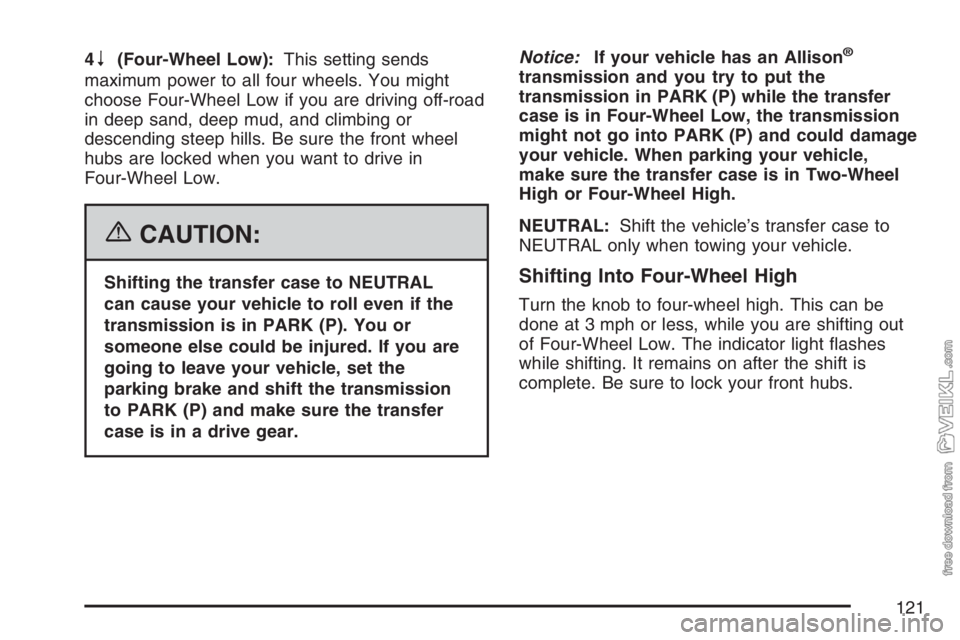
4n(Four-Wheel Low):This setting sends
maximum power to all four wheels. You might
choose Four-Wheel Low if you are driving off-road
in deep sand, deep mud, and climbing or
descending steep hills. Be sure the front wheel
hubs are locked when you want to drive in
Four-Wheel Low.
{CAUTION:
Shifting the transfer case to NEUTRAL
can cause your vehicle to roll even if the
transmission is in PARK (P). You or
someone else could be injured. If you are
going to leave your vehicle, set the
parking brake and shift the transmission
to PARK (P) and make sure the transfer
case is in a drive gear.Notice:If your vehicle has an Allison
®
transmission and you try to put the
transmission in PARK (P) while the transfer
case is in Four-Wheel Low, the transmission
might not go into PARK (P) and could damage
your vehicle. When parking your vehicle,
make sure the transfer case is in Two-Wheel
High or Four-Wheel High.
NEUTRAL:Shift the vehicle’s transfer case to
NEUTRAL only when towing your vehicle.
Shifting Into Four-Wheel High
Turn the knob to four-wheel high. This can be
done at 3 mph or less, while you are shifting out
of Four-Wheel Low. The indicator light flashes
while shifting. It remains on after the shift is
complete. Be sure to lock your front hubs.
121
Page 122 of 430
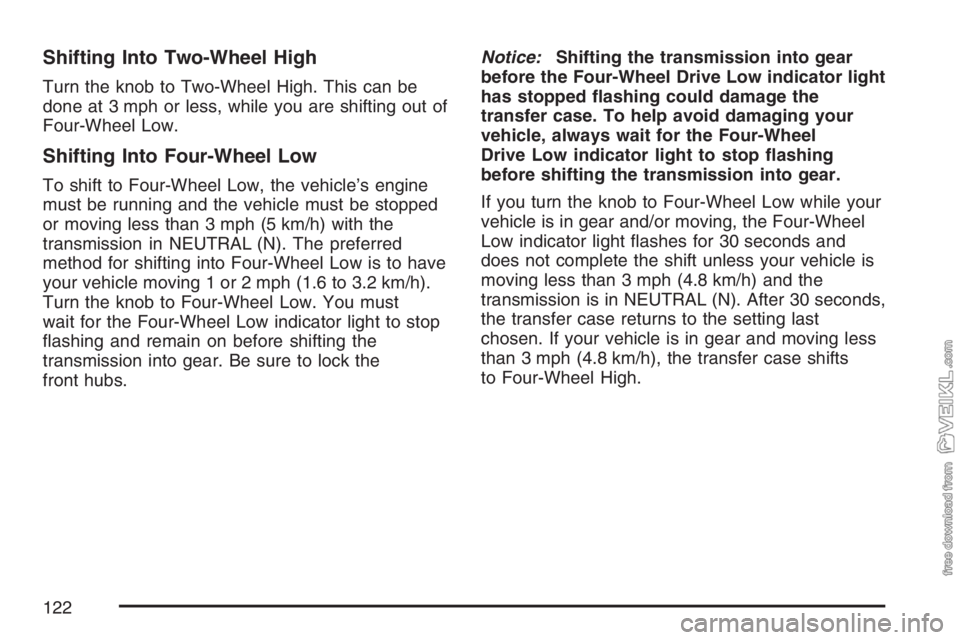
Shifting Into Two-Wheel High
Turn the knob to Two-Wheel High. This can be
done at 3 mph or less, while you are shifting out of
Four-Wheel Low.
Shifting Into Four-Wheel Low
To shift to Four-Wheel Low, the vehicle’s engine
must be running and the vehicle must be stopped
or moving less than 3 mph (5 km/h) with the
transmission in NEUTRAL (N). The preferred
method for shifting into Four-Wheel Low is to have
your vehicle moving 1 or 2 mph (1.6 to 3.2 km/h).
Turn the knob to Four-Wheel Low. You must
wait for the Four-Wheel Low indicator light to stop
flashing and remain on before shifting the
transmission into gear. Be sure to lock the
front hubs.Notice:Shifting the transmission into gear
before the Four-Wheel Drive Low indicator light
has stopped �ashing could damage the
transfer case. To help avoid damaging your
vehicle, always wait for the Four-Wheel
Drive Low indicator light to stop �ashing
before shifting the transmission into gear.
If you turn the knob to Four-Wheel Low while your
vehicle is in gear and/or moving, the Four-Wheel
Low indicator light flashes for 30 seconds and
does not complete the shift unless your vehicle is
moving less than 3 mph (4.8 km/h) and the
transmission is in NEUTRAL (N). After 30 seconds,
the transfer case returns to the setting last
chosen. If your vehicle is in gear and moving less
than 3 mph (4.8 km/h), the transfer case shifts
to Four-Wheel High.
122
Page 123 of 430
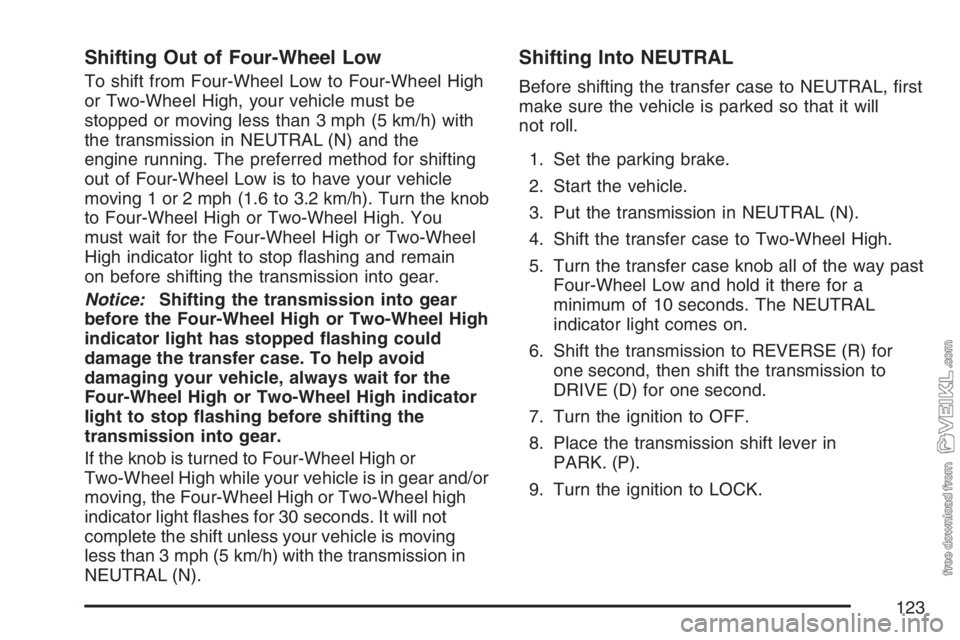
Shifting Out of Four-Wheel Low
To shift from Four-Wheel Low to Four-Wheel High
or Two-Wheel High, your vehicle must be
stopped or moving less than 3 mph (5 km/h) with
the transmission in NEUTRAL (N) and the
engine running. The preferred method for shifting
out of Four-Wheel Low is to have your vehicle
moving 1 or 2 mph (1.6 to 3.2 km/h). Turn the knob
to Four-Wheel High or Two-Wheel High. You
must wait for the Four-Wheel High or Two-Wheel
High indicator light to stop flashing and remain
on before shifting the transmission into gear.
Notice:Shifting the transmission into gear
before the Four-Wheel High or Two-Wheel High
indicator light has stopped �ashing could
damage the transfer case. To help avoid
damaging your vehicle, always wait for the
Four-Wheel High or Two-Wheel High indicator
light to stop �ashing before shifting the
transmission into gear.
If the knob is turned to Four-Wheel High or
Two-Wheel High while your vehicle is in gear and/or
moving, the Four-Wheel High or Two-Wheel high
indicator light flashes for 30 seconds. It will not
complete the shift unless your vehicle is moving
less than 3 mph (5 km/h) with the transmission in
NEUTRAL (N).
Shifting Into NEUTRAL
Before shifting the transfer case to NEUTRAL, first
make sure the vehicle is parked so that it will
not roll.
1. Set the parking brake.
2. Start the vehicle.
3. Put the transmission in NEUTRAL (N).
4. Shift the transfer case to Two-Wheel High.
5. Turn the transfer case knob all of the way past
Four-Wheel Low and hold it there for a
minimum of 10 seconds. The NEUTRAL
indicator light comes on.
6. Shift the transmission to REVERSE (R) for
one second, then shift the transmission to
DRIVE (D) for one second.
7. Turn the ignition to OFF.
8. Place the transmission shift lever in
PARK. (P).
9. Turn the ignition to LOCK.
123
Page 141 of 430
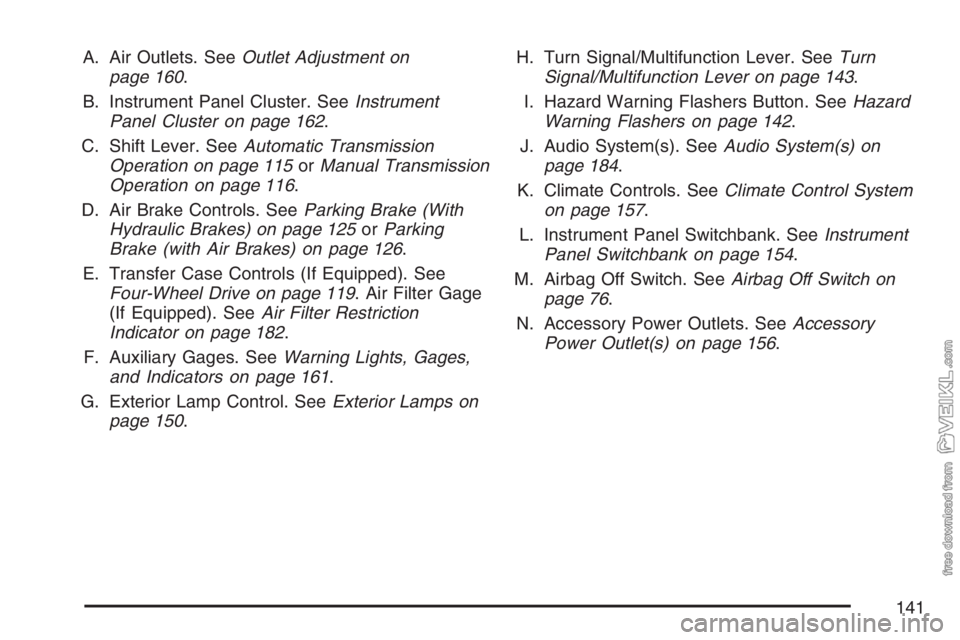
A. Air Outlets. SeeOutlet Adjustment on
page 160.
B. Instrument Panel Cluster. SeeInstrument
Panel Cluster on page 162.
C. Shift Lever. SeeAutomatic Transmission
Operation on page 115orManual Transmission
Operation on page 116.
D. Air Brake Controls. SeeParking Brake (With
Hydraulic Brakes) on page 125orParking
Brake (with Air Brakes) on page 126.
E. Transfer Case Controls (If Equipped). See
Four-Wheel Drive on page 119. Air Filter Gage
(If Equipped). SeeAir Filter Restriction
Indicator on page 182.
F. Auxiliary Gages. SeeWarning Lights, Gages,
and Indicators on page 161.
G. Exterior Lamp Control. SeeExterior Lamps on
page 150.H. Turn Signal/Multifunction Lever. SeeTurn
Signal/Multifunction Lever on page 143.
I. Hazard Warning Flashers Button. SeeHazard
Warning Flashers on page 142.
J. Audio System(s). SeeAudio System(s) on
page 184.
K. Climate Controls. SeeClimate Control System
on page 157.
L. Instrument Panel Switchbank. SeeInstrument
Panel Switchbank on page 154.
M. Airbag Off Switch. SeeAirbag Off Switch on
page 76.
N. Accessory Power Outlets. SeeAccessory
Power Outlet(s) on page 156.
141
Page 154 of 430
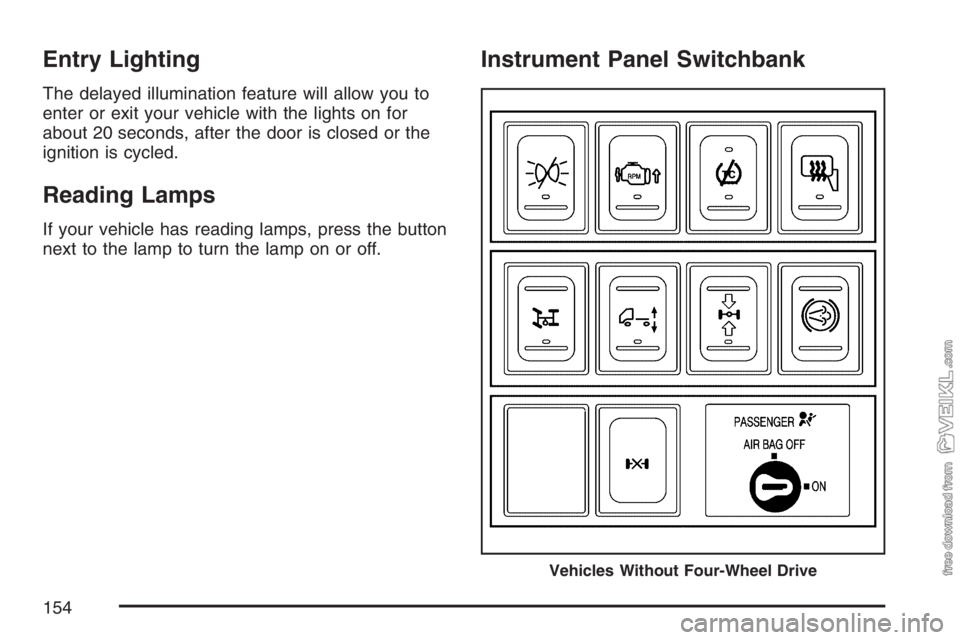
Entry Lighting
The delayed illumination feature will allow you to
enter or exit your vehicle with the lights on for
about 20 seconds, after the door is closed or the
ignition is cycled.
Reading Lamps
If your vehicle has reading lamps, press the button
next to the lamp to turn the lamp on or off.
Instrument Panel Switchbank
Vehicles Without Four-Wheel Drive
154
Page 233 of 430
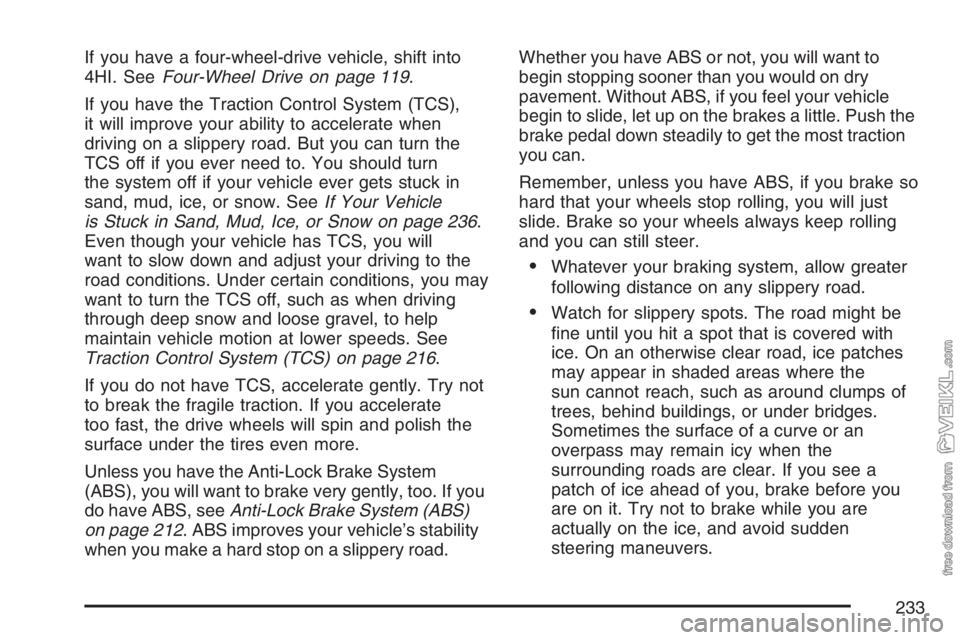
If you have a four-wheel-drive vehicle, shift into
4HI. SeeFour-Wheel Drive on page 119.
If you have the Traction Control System (TCS),
it will improve your ability to accelerate when
driving on a slippery road. But you can turn the
TCS off if you ever need to. You should turn
the system off if your vehicle ever gets stuck in
sand, mud, ice, or snow. SeeIf Your Vehicle
is Stuck in Sand, Mud, Ice, or Snow on page 236.
Even though your vehicle has TCS, you will
want to slow down and adjust your driving to the
road conditions. Under certain conditions, you may
want to turn the TCS off, such as when driving
through deep snow and loose gravel, to help
maintain vehicle motion at lower speeds. See
Traction Control System (TCS) on page 216.
If you do not have TCS, accelerate gently. Try not
to break the fragile traction. If you accelerate
too fast, the drive wheels will spin and polish the
surface under the tires even more.
Unless you have the Anti-Lock Brake System
(ABS), you will want to brake very gently, too. If you
do have ABS, seeAnti-Lock Brake System (ABS)
on page 212. ABS improves your vehicle’s stability
when you make a hard stop on a slippery road.Whether you have ABS or not, you will want to
begin stopping sooner than you would on dry
pavement. Without ABS, if you feel your vehicle
begin to slide, let up on the brakes a little. Push the
brake pedal down steadily to get the most traction
you can.
Remember, unless you have ABS, if you brake so
hard that your wheels stop rolling, you will just
slide. Brake so your wheels always keep rolling
and you can still steer.
•Whatever your braking system, allow greater
following distance on any slippery road.
•Watch for slippery spots. The road might be
fine until you hit a spot that is covered with
ice. On an otherwise clear road, ice patches
may appear in shaded areas where the
sun cannot reach, such as around clumps of
trees, behind buildings, or under bridges.
Sometimes the surface of a curve or an
overpass may remain icy when the
surrounding roads are clear. If you see a
patch of ice ahead of you, brake before you
are on it. Try not to brake while you are
actually on the ice, and avoid sudden
steering maneuvers.
233